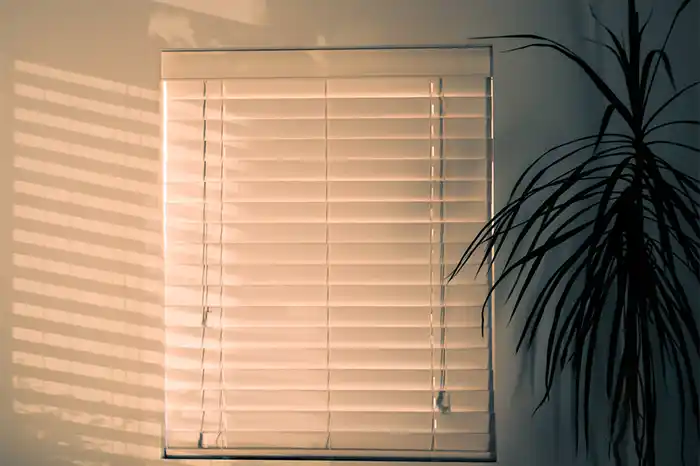The selection of office blinds brings appropriate aesthetics and productivity. Many benefits associated with office blinds, such as light, privacy, and energy efficiency, make them crucial for a working environment. When upgraded, office windows can appear professional while giving a cozy and comfortable vibe.
Recent studies also indicate that a designed office will improve the morale and effectiveness of the workers. Knowing the variety of blinds available is essential, even for redesigning or establishing a new office. In this guide, we’ll explore various office blind ideas to help you make an informed decision. Read on to discover how to choose the best blinds for your office.
7 Factors to Consider When Selecting the Ideal Office Window Blinds
1. Assess Light Control Needs

Rooms like meeting spaces may need dark-colored or black blinds for presentations to eliminate glare and enhance visibility. For general workspaces, opt for light-filtering blinds that reduce harsh sunlight while allowing natural light to permeate.
Observe the office’s orientation and how sunlight impacts different times of the day. Excessive sunlight can cause discomfort and reduce productivity, while too little light can strain the eyes. These are some of the best office blinds for glare control.
- Roller Blinds: Offer adjustable light control with various opacity levels.
- Vertical Blinds: Ideal for large windows, providing precise light adjustment.
- Venetian Blinds: Allow fine-tuned control of light with tilting slats.
- Solar Shades: Reduce glare while preserving outdoor views.
- Blackout Blinds: Completely block light for maximum glare control.
- Day and Night Blinds: Combine sheer and opaque fabrics for versatile light management.
2. Determine Privacy Requirements

Look at the various office areas and their need for privacy. For rooms dealing with confidential information, like HR or executive offices, use blackout or Venetian blinds to ensure they have the most amount of privacy.
In open-plan spaces, one may use semi-transparent blinds, allowing light to filter in but maintaining some level of privacy. Be aware of outward visibility if your office is located on the lower levels or where the windows look out onto busy streets. Adjustable slat blinds, such as vertical or Venetian, provide flexibility in privacy control.
To find the sweet spot between privacy and natural light, think about blinds that allow light in but obscure direct views. Frosted or patterned options are ideal for maintaining a bright yet private workspace.
3. Evaluate Energy Efficiency

Blinds can assist with regulating office temperature, thereby saving energy costs. Begin by identifying the places that gain a lot of heat during summer or lose heat during winter. Search for energy-efficient window coverings that trap air and provide another insulated layer. Below are excellent eco-friendly office blinds options:
- Honeycomb Blinds: Offer excellent insulation and are often made from recycled materials.
- Solar Shades: Attenuate glare and heat gain whilst utilizing eco-friendly fabrics.
- Bamboo Blinds: Natural and sustainable – efficient in controlling light and keeping out heat and cold.
- Recycled Fabric Blinds: Made from recycled materials, they help in saving energy as well as the environment.
- Light-Colored Blinds: Drives sunlight away and maintains the office cool.
- Automated Blinds: Adjust based on the time of day or temperature, contributing to energy efficiency.
4. Consider Durability and Maintenance
Office blinds offer many durable and low-maintenance options that are perfect for office settings. Opt for materials known for their longevity. Aluminum blinds resist wear and are easy to clean. Faux wood blinds provide the look of wood but with better moisture resistance and durability. Vinyl blinds are another sturdy option, especially for high-traffic areas.
Evaluate the cleaning requirements. Blinds that attract less dust and are simple to clean, like vertical and roller blinds, are ideal for busy offices. Avoid materials that need special care or are prone to damage. Selecting durable, low-maintenance blinds ensures they remain functional and attractive over time.
5. Match Aesthetic Preferences

The blinds must ensure a harmonious look that matches office aesthetics. Select colors that can blend with the existing color palette. Neutral colors such as white, beige, or gray tend to be flexible and professional, giving a modern or minimalist design to the office, whereas bold colors may add some vibrancy.
The style of the blind will also differ. Roller blinds offer a sleek, modern look, while wooden or faux wood blinds add warmth and a classic touch. Vertical blinds are ideal for large windows and offer a contemporary feel. The texture of the blinds also plays a role; smooth finishes provide a clean look, while textured fabrics can add depth and interest.
Also Read: Cocobolo Desk
6. Measure Window Dimensions
Accurate measurements are important to ensure proper fit. Use these tips to measure window dimensions for properly fitted office window blinds:
- Use a Metal Tape Measure: For accuracy, use a metal one instead of the textile tape measure.
- Measure Width First: Measure the width at the top, middle, and bottom of the window. Use the narrowest measurement.
- Measure Height Next: Measure the height at the left, middle, and right sides of the window. Use the longest measurement.
- Account for Obstacles: Record the handles, locks, and obstacles that would impact installation.
- Double-check Measurements: Verify each measurement twice to avoid mistakes.
- Consider Mounting Options: Decide if you’ll mount the blinds inside or outside the window frame, as this affects the measurements.
- Record Measurements Clearly: Write down your measurements clearly and label them properly to avoid confusion.
7. Explore Automation Options
Motorized blinds in smart offices permit you to play with light and discretion using the touch of a button or from a smartphone. They can be programmed to adjust automatically based on the time of day or specific lighting conditions, ensuring an optimal office environment throughout the day.
These blinds are particularly useful in hard-to-reach areas or for large windows, where manual operation can be cumbersome. Integrating motorized blinds with existing smart office systems, such as lighting and HVAC, can contribute to energy savings and improved comfort.
When selecting motorized blinds, consider the ease of use, compatibility with other smart devices, and available power options, such as battery or hardwired systems.
Read More: Smart Home Trends
Final Thoughts
With the correct blinds for office windows, you can transform and optimize your working space for good. There are several ways one could control the lights, ensure privacy, save energy, and be quite durable to enhance comfort and productivity. Quality blinds also improve aesthetics in general as they offer a professional and cohesive look.
Integrate with some motorized options for further modernization in the office, making things easier and saving time. Certainly, quality blinds add to making the workspace productive and comfortable.





